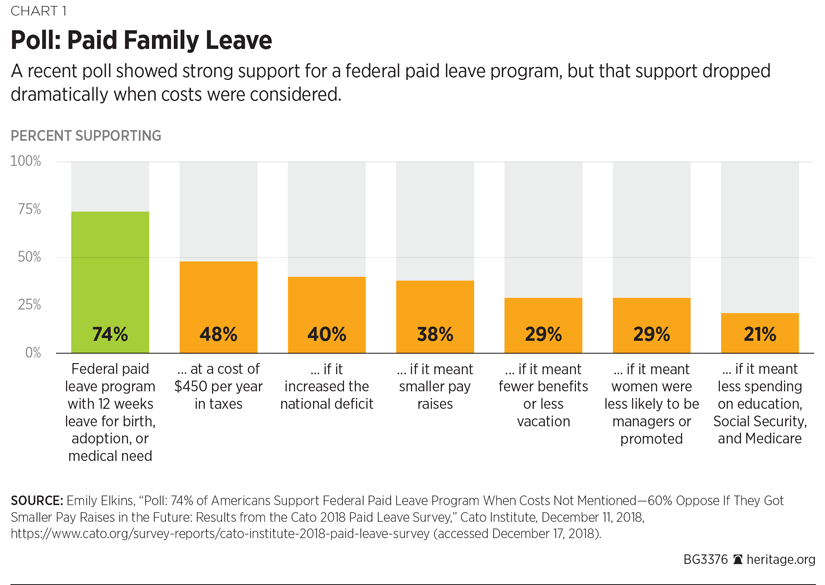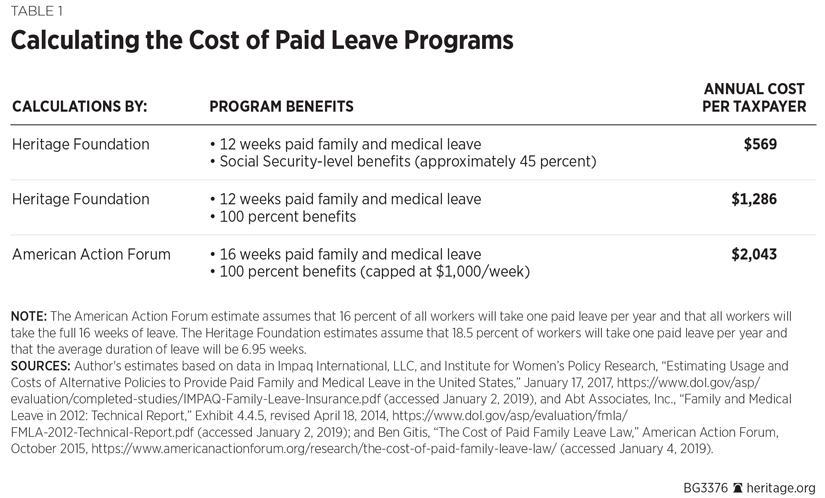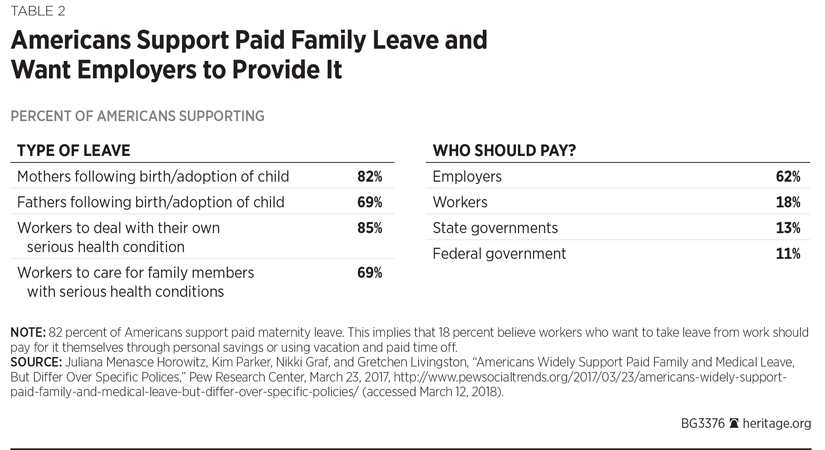A majority of Americans support a federal paid family leave program—but only if they do not have to pay for it.
According to a new survey by the Cato Institute, 74 percent of adults support a federal government program that would provide workers with 12 weeks of paid leave following the birth or adoption of a child, or to care for their, or a family member’s, illness.REF
Fewer than half said they would support such a program if it meant higher taxes or debt, lower benefits, fewer women promoted, or lower spending on education and entitlement programs. This lack of support for trade-offs is important, because a federal program would come with significant costs.
The high level of support for paid family leave is not surprising considering that 25 percent of workers in the Cato study reported having a want or need for family leave within just the past year. A Pew study found that 27 percent of workers reported having taken time off for parental, family, or medical leave within the past two years. When considering leave already taken, as well as that anticipated in the future, 62 percent of Americans have taken, or expect to take, family or medical leave.REF
What Are Americans Willing to Trade for Federal Paid Family Leave?
While Americans support paid family leave, their support dwindles once faced with trade-offs that would come with a federal program.

Higher Taxes. When asked if they would support a 12-week program that cost them $450 more in taxes per year, only 48 percent of respondents supported a national paid leave program. This amount is likely far less than even a modest federal paid family leave program would cost. At the state level, where existing programs are little known, limited, and underutilized, median costs range from $109 in additional taxes per year for workers in New Jersey (a six-week program with roughly 60 percent benefits) to $384 in Rhode Island (a four-week program with roughly 66 percent benefits).REF
When asked, without regard to costs, if they supported a more generous 26-week paid leave program, 48 percent of Americans supported it.REF Support dropped to 32 percent at a cost of $525 per year in new taxes. Those supporting a generous program despite higher taxes were relatively insensitive to the size of tax increase necessary to fund a program; support fell only 4 percentage points—to 28 percent—when the tax cost quadrupled to $2,100.REF
In reality, a national paid leave program would likely cost much more than $450—the level at which more Americans opposed a federal program. The American Action Forum estimated that enacting a national paid family leave program that provided 16 weeks of paid leave with benefits of up to $1,000 per week would cost at least $1,800 in additional taxes for the average worker, and could cost as much as $11,000 in additional taxes each year.REF
This upper range is in line with expenditures in countries that provide generous paid family leave programs. Excluding the costs of employer mandates, Organization for Economic Co-operation and Development countries spend an average of $12,300 in public funds for every child born, and some countries spend upwards of $35,000 per child born.REF

A Heritage Foundation study estimated that a federal paid maternity leave program that provided up to 12 weeks of benefits, equal to about 50 percent to 60 percent of regular pay (based on the Social Security benefit formula), would cost $114 billion over 10 years.REF Providing benefits equal to 100 percent of pay would raise the cost to $198 billion over 10 years, and expanding the leave to include all family medical leave as opposed to just parental leave would cost $231 billion.
Those estimates understate the true costs of a federal paid leave program because they do not take into account the behavioral responses of workers and employers. Workers would almost certainly take more paid family leave than before, because it would have no direct monetary cost to them, and employers and states that provide paid family leave would likely drop their existing programs and simply let their workers use the federal program instead.
Assuming that about 18.5 percentREF of workers would use a federal paid family leave program each year, and that these workers would take an average of 6.95 weeks,REF providing Social Security–level benefits roughly equal to 45 percent of pay would cost each taxpayer an additional $569 per year ($85.5 billion total), while providing benefits equal to 100 percent of pay would increase the annual cost per taxpayer to $1,286 ($193 billion total).REF A federal policy would not be cost-free to employers, either, because they would have to keep paying for benefits, such as health insurance, while their workers took leave. Twelve weeks of an average family health insurance plan would cost employers about $4,500.REF
Higher GovernmentDebt. Americans were even less willing (40 percent) to support a paid leave program if it meant higher government debt instead of higher taxes. Even at a tax increase of $1,200, more Americans (43 percent) supported a tax-financed federal paid family leave program than a deficit-financed one. This lack of support among Americans for ever-higher deficit-financed spending is good news, because the U.S. debt has become so high, that it has arguably become one of America’s greatest threats. If Americans do not want to increase the debt in order to establish a paid family leave program, and they also do not want to reduce other major spending programs (see below), a federal paid family leave program should not be a priority for policymakers. Congress and the Administration should instead focus on making it easier for employers to provide workers with the flexibility of accruing paid time off, and for individuals to be able to save for more of their own needs through, for example, a universal savings account.REF
Lower Pay, Fewer Promotions, Reduced Benefits. Compared to paying higher taxes or increasing deficits, the Cato study found that Americans were less willing to give up their own personal compensation or to forego promotions for women. Only 29 percent of adults supported a federal paid family leave program if it meant fewer benefits for them or a reduced likelihood of promotions for women. That is an important consideration because evidence shows that mandated family leave—even when unpaid—reduces women’s chances for promotion.REF If the government were to require employers to provide paid family leave, it would likely lead to hiring discrimination against women of child-bearing age, particularly, as suggested by Harry Holzer of the Urban Institute, less-educated and minority women.REF Moreover, generous national paid leave programs, such as found in Europe, have reduced women’s wages and career prospects.REF
Reduced Spending on Other Government Programs. Americans were least willing to support a federal paid family leave program if it would require giving up other highly valued government services. Only 21 percent of those in the Cato study said they would trade a national paid family leave program for lower funding for education, Social Security, and Medicare. Considering the already unsustainable nature of Social Security and Medicare, and crowding out of education funding by public pension costs, the necessary cost reductions in these programs must go toward keeping the programs solvent, as opposed to adding a new entitlement program. Congress already tapped into Medicare savings to help cover some of the tremendous costs of Obamacare, leaving the program with even less room for future savings. Policymakers need to address the unsustainable nature of existing government commitments before adding new ones.
Is a National Program Needed?
It is good to know what workers are and are not willing to give up in exchange for a federal paid family leave program. Even more important is the question of whether a national paid family leave program is even necessary. The Cato study, along with recent growth in voluntary private paid family leave programs, as well as state-based ones, across the U.S. suggests it is not.
The oft-cited Bureau of Labor statistic that only 15 percent of workers have access to paid family leave is based on an extremely limited definition of paid leave and thus does not accurately reflect the real percentage.REF After all, 20 percent of the population has access to state-based paid family leave programs,REF and 34 percent of workers report having access to employer-provided paid family leave.REF Moreover, a recent survey from the Society for Human Resource Management found that the percent of companies offering paid leave nearly tripled over the past four years, from 12 percent in 2014 to 35 percent in 2018.REF
The Cato study finds a very narrow gap between those who want or need to take family leave and those who receive it: 25 percent of workers said they wanted or needed to take leave in the past year, while fully 24 percent said they took leave. Of those who took leave, 75 percent reported receiving either full or partial pay, while 48 percent reported at least some portion of their leave as unpaid.REF The Pew study found that 63 percent of workers who had taken family or medical leave in the past two years received full (47 percent) or partial pay (16 percent), while 36 percent received no pay.REF
While not all Americans have access to paid family leave—and some workers either cannot take leave that they need or want, and others have to take less leave than desired or sacrifice needed pay—this gap does not necessitate a costly new federal entitlement program. A limited federal paid family leave program would not provide the amount of leave or the level of pay desired by workers, and a generous one would include enormous costs and bring about unintended consequences, such as hiring discrimination against, and lower pay and promotions, for women. A better solution is to allow the private sector to continue expanding access to paid family leave through voluntary employer-provided programs. Evidence shows this is what most Americans want.
Who Should Pay for Paid Leave?
According to a 2017 Pew study, of the 85 percent of Americans who said that workers should receive paid family leave, 62 percent thought employers should pay for it, while 24 percent thought the government—including the federal government (11 percent) or state and local governments (13 percent)—should pay for it.REF

Employers and individual workers are the most logical providers of paid family leave because they are the ones who benefit from it. Workers benefit from being able to take time off from work when needed, and employers benefit from paid leave through higher employee retention, improved morale, and from the perceived value of paid leave policies as part of total compensation.
A Federal Program Would Crowd Out Existing Paid Leave Programs and Stifle New Ones. Although the U.S. is among one of the only developed countries without a national paid family leave program, it has the most extensive system of private and state-based paid leave programs. As more workers desire paid leave, more employers are offering it. Over the past three years, more than 100 large, name-brand companies announced new or expanded paid family leave programs,REF and the largest 20 employers in the U.S. all provide paid family leave.REF Now is not the time to stifle this growth or to crowd out existing policies with a federal paid leave program.
While some employers may still offer their own programs, they would almost certainly do so only after tapping the taxpayer-provided program. Carolyn O’Boyle, representing Deloitte, testified at a July 11, 2018, Senate Finance Subcommittee hearing; she said that Deloitte instructs its workers to first utilize the state-provided paid leave benefits, before Deloitte then tops those benefits off to total Deloitte’s maximum benefits. All logically thinking business owners and state policymakers would do the same, meaning that a new federal program would shift costs currently born by employers and states onto federal taxpayers.
Workers are arguably better off with employer-provided paid family leave programs that better limit the costs and consequences of paid leave. Employer-provided programs can better meet individual workers’ needs on a timely and more effective basis than could a one-size-fits-all federal program. A federal program would necessarily require all sorts of rules and regulations to ensure its integrity. The inept federal Disability Insurance program provides evidence of the inability of a large, bureaucratic national program to meet individual workers’ needs on a timely basis and in a just manner.REF
Alternative Policies to Support More Paid Family Leave
Instead of pushing for a federal program, policymakers can help encourage greater access to paid family leave through alternative policies.
The Working Families Flexibility Act would allow private employers to offer their employees the choice of receiving paid leave instead of time-and-a-half pay in exchange for overtime hours (something already available to public-sector employees).REF
Universal Savings Accounts would give workers the option to use tax-deferred savings for family or medical leave. While not all workers have the ability to save, offering a savings account that workers could access anytime (as opposed to only in retirement or for education expenses) would almost certainly increase overall savings in the U.S.
Finally, lower taxes and fewer regulations would free up resources so that more businesses could offer paid family leave to their workers. Following the Tax Cuts and Jobs Act, dozens of major companies announced that they were using their newly freed resources to create or expand paid family leave programs.REF
While access to paid family leave in the U.S. is growing, a significant number of Americans still do not have access to paid family leave. Most Americans believe they will want or need to take family or medical leave at some point, and they want it to be available to all Americans. This poll shows, however, that Americans are not willing to accept the trade-offs required to provide a federal paid leave program. Thus, policymakers should work toward solutions that will increase access to paid family leave without enacting a new national entitlement.
—Rachel Greszler is Research Fellow in Economics, Budget, and Entitlements in the Grover M. Hermann Center for the Federal Budget, of the Institute for Economic Freedom, at The Heritage Foundation.



